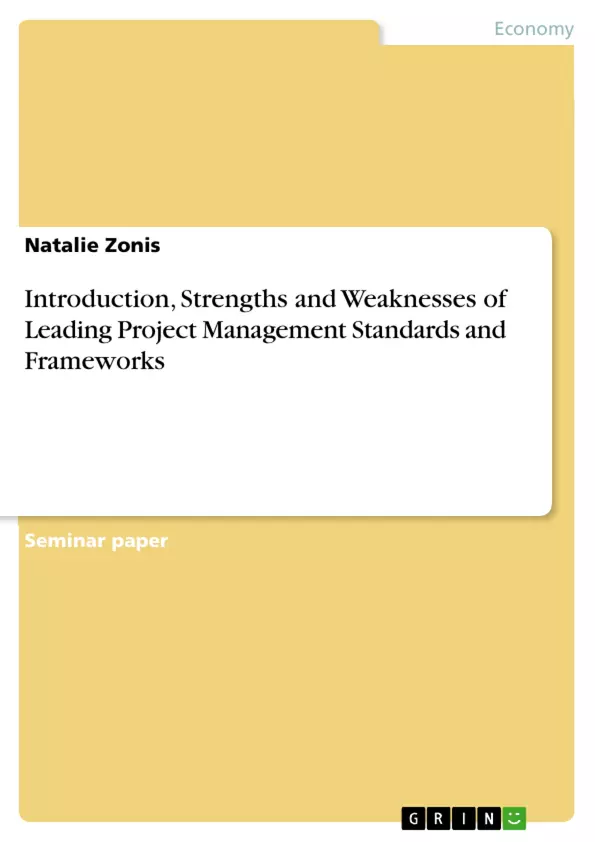What do the construction of the Pyramids of Giseh or of the Great Wall of China, Hannibal’s Alps crossing and the Berlin Airlift have in common? These all are examples for famous and inspiring historical projects which would have never been realized without a profound planning, execution, coordination, and control. Mankind seems to have a lot of experience coming from fields like construction, engineering and defense on one hand.
On the other hand we almost daily hear about projects that have failed or haven’t met customers’ expectations and as a result have even ruined whole companies and organizations.
Every year 75 Billion US Dollars have been spent on failing projects only in IT-sector. Only 17 percent of all software projects done in the United States meet the original targets, 50 percent must have those target changed. All that happens today, when branches and industries are faced with rough economic and highly competitive environments with an increasing market concentration and fragility which shortens product life cycles and puts very strong requirements to costs and quality.
To reduce risks of failure, to collect knowledge, to benefit from own and others’ experiences and to give guidelines to the project personnel project management was systematically developed as an outstanding discipline with its’ own standards and guides. The emergence and recognition of a distinct profession of project management has certainly been a strong driver in the development of standards and frameworks.
The need to understand and to specify the role of the project manager himself, for a common terminology and the necessity of a common basis for employment and deployment of project personnel, working collaboratively, across functions in multidisciprinary teams; across organizations in strategic alliances and joint ventures; and across continents in global projects – these were the significant factors for the development of standards world wide .
This Term Paper presents an overview of the leading project management standards and guides for project management knowledge and performance including a comparison of their content, strengths and weeknesses.
Table of Contents
- Introduction
- Project Management
- Definitions
- History of Project Management
- Modern Project Management
- Existing Generic Standards and Frameworks
- Focused on Projects
- PMI PMBOK
- APM – APM BOK
- IPMA / GPM - ICB
- PMAJ - P2M
- Focused on People
- AIPM
- OSCEng
- Focused on Organizations
- PRINCE2
- P2M
- OPM3
- MSP
- Focused on Projects
- The Benefits of Framework Implementation
- Comparison of Leading Standards and Frameworks
Objectives and Key Themes
This term paper provides a comprehensive overview of leading project management standards and guides, aiming to analyze their content, strengths, and weaknesses. The paper aims to contribute to the understanding of how these standards and frameworks contribute to successful project management practices. Key themes explored in the paper include:- Definitions and historical development of project management
- Overview of prominent project management standards and frameworks
- Categorization of standards based on their focus (projects, people, or organizations)
- Benefits of implementing project management frameworks
- Comparison of leading standards and frameworks, highlighting their strengths and weaknesses.
Chapter Summaries
The introduction sets the stage by highlighting the significance of project management in various historical contexts. It emphasizes the importance of effective planning, execution, and control in achieving successful project outcomes. The chapter also underscores the increasing demand for project management expertise in today's competitive business environment.
Chapter 2 delves into the concept of project management, providing definitions of "project" and "project management." It explores the historical development of the discipline, emphasizing its evolution as a distinct profession. The chapter also discusses the need for standards and frameworks to guide project management practices.
Chapter 3 presents an overview of existing generic standards and frameworks, categorized based on their focus: projects, people, or organizations. The chapter provides a detailed examination of several key standards, including PMI PMBOK, APM BOK, IPMA/GPM ICB, PMAJ P2M, AIPM, OSCEng, PRINCE2, P2M, OPM3, and MSP. Each standard is discussed in terms of its key features, objectives, and strengths.
Chapter 4 explores the benefits of implementing project management frameworks. It highlights the advantages of adopting standardized approaches, such as improved communication, coordination, and consistency in project execution. The chapter also discusses the role of frameworks in minimizing project risks and maximizing project success.
Keywords
Key topics and concepts explored in this paper include project management standards, frameworks, project management knowledge, project performance, PMI PMBOK, APM BOK, IPMA/GPM ICB, PMAJ P2M, AIPM, OSCEng, PRINCE2, P2M, OPM3, MSP, and the benefits of implementing project management frameworks.- Citar trabajo
- Natalie Zonis (Autor), 2009, Introduction, Strengths and Weaknesses of Leading Project Management Standards and Frameworks, Múnich, GRIN Verlag, https://www.grin.com/document/164884



